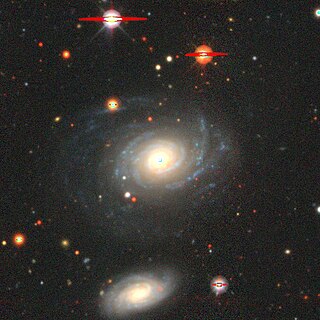
NGC 1 is an intermediate spiral galaxy of the morphological type Sbc, located in the constellation of Pegasus. It was discovered on 30 September 1861 by Heinrich d'Arrest.
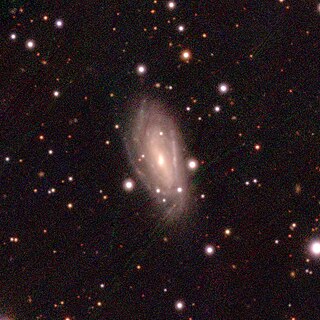
The New General Catalogue object NGC 48 is a barred spiral galaxy located approximately 79.3 million light-years from the Solar System in the constellation Andromeda.

NGC 5566 is a barred spiral galaxy in the constellation Virgo, which is approximately 66 million light years away from Earth. The galaxy is the biggest in the constellation Virgo, stretching nearly 150,000 light years in diameter. The galaxy NGC 5566 was discovered on 30 April 1786 by the German-British astronomer William Herschel. It is included in Halton Arp's Atlas of Peculiar Galaxies. It is a member of the NGC 5566 Group of galaxies, itself one of the Virgo III Groups strung out to the east of the Virgo Supercluster of galaxies.

NGC 51 is a lenticular galaxy in the constellation Andromeda. It has a diameter of 90,000 light-years. The galaxy was discovered on September 7, 1885, by Lewis Swift, who described it as "Pretty faint, pretty small, round, brighter middle."

NGC 359 is an elliptical galaxy located approximately 238 million light-years from the Solar System in the constellation Cetus. It was discovered on September 2, 1864, by Albert Marth. It was described by Dreyer as "extremely faint, very small."
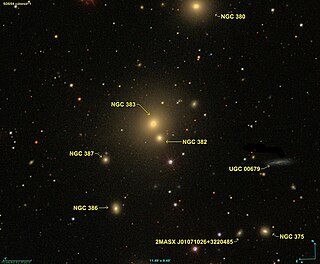
NGC 382 is an elliptical galaxy located in the constellation Pisces. Its discovery has been credited to William Parsons.

NGC 507, also known as Arp 229, CGCG 502-67, MCG 5-4-44, PGC 5098, UGC 938, and V V 207, is a lenticular galaxy in the constellation Pisces. It was described as being "very faint", "pretty large", "round", "brighter in the middle", and "south of NGC 508" by John Dreyer in the New General Catalogue. The two galaxies are a part of the Atlas of Peculiar Galaxies, where NGC 507 is described as "Circular or near circular rings of small density difference."

NGC 468 is a spiral galaxy in the constellation Pisces. Located approximately 209 million light-years from Earth, it was discovered by John Frederick William Herschel in 1827.
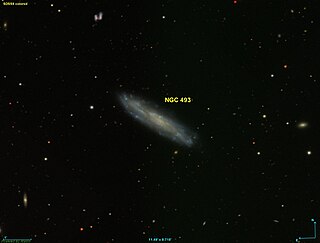
NGC 493, also occasionally referred to as PGC 4979 or GC 281, is a barred spiral galaxy in the constellation Cetus. It is located approximately 90 million light-years from Earth and was discovered on December 20, 1786 by astronomer William Herschel. It was later also observed by his son, John Herschel. John Dreyer, creator of the New General Catalogue, described the galaxy as "very faint, large, much extended 60°" with "a little brighter middle".

NGC 6670 is a pair of interacting galaxies within the Draco constellation, which lie around 401 million light-years from Earth. Its shape resembles a leaping dolphin. NGC 6670 was discovered by Lewis A. Swift on July 31, 1886. NGC 6670 is a combination of two colliding disc galaxies which are known as NGC 6670E and NGC 6670W. The galaxy is 100 billion times brighter than the Sun. The galaxies have already collided once before and they are now moving towards each other again nearing a second collision. Its apparent magnitude is 14.3, its size is 1.0 arc minutes.

NGC 495, also occasionally referred to as PGC 5037, UGC 920 or GC 278, is a barred spiral galaxy in the constellation Pisces. It is located approximately 184 million light-years from the Solar System and was discovered on 12 September 1784 by astronomer William Herschel.

NGC 499, also occasionally referred to as PGC 5060, IC 1686 or GC 289, is a lenticular galaxy in the constellation Pisces. It is located approximately 197 million light-years from the Solar System and was discovered on 12 September, 1784 by astronomer William Herschel.

NGC 1510 is a dwarf lenticular galaxy approximately 38 million light-years away from Earth in the constellation of Horologium. It was discovered by John Herschel on December 4, 1836.

NGC 497 is a barred spiral galaxy approximately 336 million light-years away from Earth in the constellation of Cetus. It was discovered by French astronomer Édouard Stephan on November 6, 1882.

NGC 806 is a spiral galaxy approximately 166 million light-years away from Earth in the constellation Cetus. It was discovered by American astronomer Lewis A. Swift on November 1, 1886 with the 16" refractor at Warner Observatory.

NGC 519, also occasionally referred to as PGC 5182, is an elliptical galaxy located approximately 242 million light-years from the Solar System in the constellation Cetus. It was discovered on 20 November 1886 by astronomer Lewis Swift.
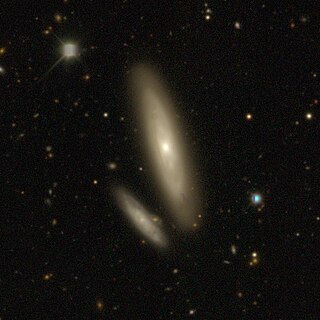
NGC 527, also occasionally referred to as PGC 5128 or PGC 5141, is a lenticular galaxy located approximately 259 million light-years from the Solar System in the constellation Sculptor. It was discovered on 1 September 1834 by astronomer John Herschel.
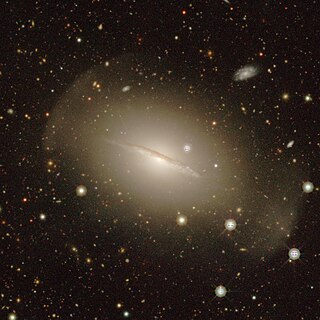
NGC 681 is an intermediate spiral galaxy in the constellation of Cetus, located approximately 66.5 million light-years from Earth. The name Little Sombrero Galaxy is a reference to a much larger and earlier observed sombrero-like galaxy designated M104, or the Sombrero Galaxy.
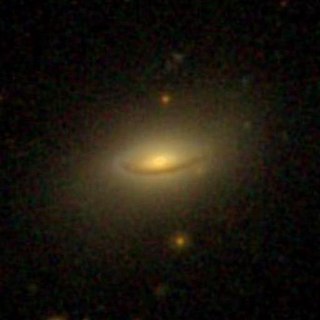
NGC 4074 is a peculiar lenticular galaxy located 310 million light-years away in the constellation Coma Berenices. It was discovered by astronomer William Herschel on April 27, 1785 and is a member of the NGC 4065 Group.

NGC 4848 is a barred spiral galaxy in the constellation Coma Berenices. It is circa 340 million light-years from Earth, which, given its apparent dimensions, means that NGC 4848 is about 170,000 light years across. It was discovered by Heinrich d'Arrest on April 21, 1865. It is considered part of the Coma Cluster, which is in its northwest part. The galaxy has been stripped of its gas as it passed through the cluster.




















